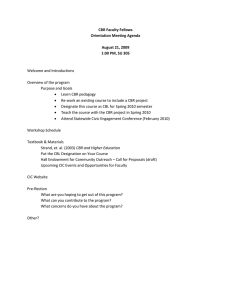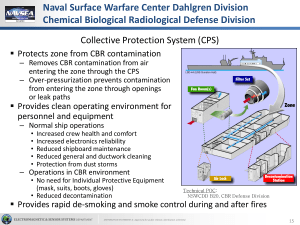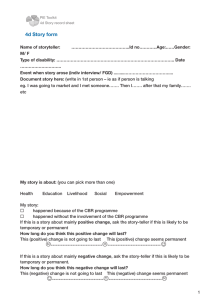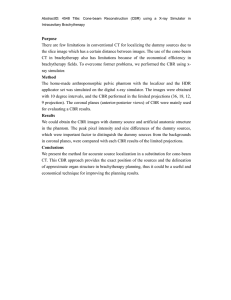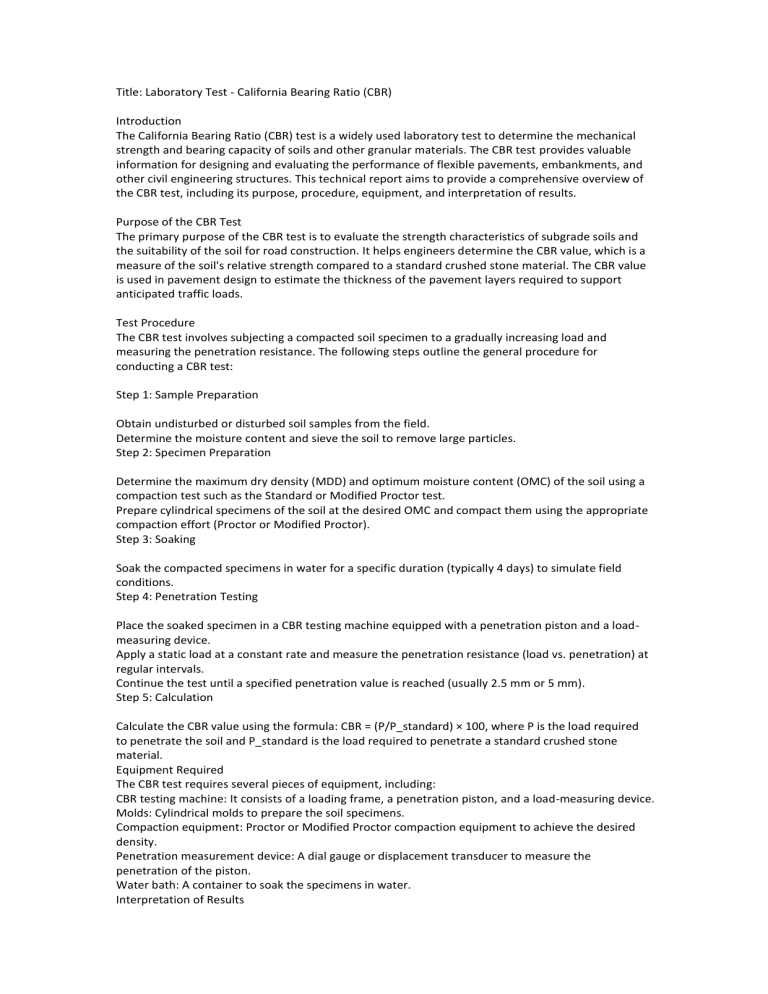
Title: Laboratory Test - California Bearing Ratio (CBR) Introduction The California Bearing Ratio (CBR) test is a widely used laboratory test to determine the mechanical strength and bearing capacity of soils and other granular materials. The CBR test provides valuable information for designing and evaluating the performance of flexible pavements, embankments, and other civil engineering structures. This technical report aims to provide a comprehensive overview of the CBR test, including its purpose, procedure, equipment, and interpretation of results. Purpose of the CBR Test The primary purpose of the CBR test is to evaluate the strength characteristics of subgrade soils and the suitability of the soil for road construction. It helps engineers determine the CBR value, which is a measure of the soil's relative strength compared to a standard crushed stone material. The CBR value is used in pavement design to estimate the thickness of the pavement layers required to support anticipated traffic loads. Test Procedure The CBR test involves subjecting a compacted soil specimen to a gradually increasing load and measuring the penetration resistance. The following steps outline the general procedure for conducting a CBR test: Step 1: Sample Preparation Obtain undisturbed or disturbed soil samples from the field. Determine the moisture content and sieve the soil to remove large particles. Step 2: Specimen Preparation Determine the maximum dry density (MDD) and optimum moisture content (OMC) of the soil using a compaction test such as the Standard or Modified Proctor test. Prepare cylindrical specimens of the soil at the desired OMC and compact them using the appropriate compaction effort (Proctor or Modified Proctor). Step 3: Soaking Soak the compacted specimens in water for a specific duration (typically 4 days) to simulate field conditions. Step 4: Penetration Testing Place the soaked specimen in a CBR testing machine equipped with a penetration piston and a loadmeasuring device. Apply a static load at a constant rate and measure the penetration resistance (load vs. penetration) at regular intervals. Continue the test until a specified penetration value is reached (usually 2.5 mm or 5 mm). Step 5: Calculation Calculate the CBR value using the formula: CBR = (P/P_standard) × 100, where P is the load required to penetrate the soil and P_standard is the load required to penetrate a standard crushed stone material. Equipment Required The CBR test requires several pieces of equipment, including: CBR testing machine: It consists of a loading frame, a penetration piston, and a load-measuring device. Molds: Cylindrical molds to prepare the soil specimens. Compaction equipment: Proctor or Modified Proctor compaction equipment to achieve the desired density. Penetration measurement device: A dial gauge or displacement transducer to measure the penetration of the piston. Water bath: A container to soak the specimens in water. Interpretation of Results The CBR value obtained from the test represents the relative strength of the soil compared to the standard crushed stone material. Higher CBR values indicate stronger and more stable soils. The interpretation of CBR results depends on the specific application and design requirements. For example, CBR values above 80 are considered excellent for road construction, while values below 2 are considered very weak. CBR test results are typically used in pavement design to determine the required pavement thickness and the selection of appropriate materials. Engineers consider the CBR values, traffic loads, and other factors to design pavements that can withstand the expected traffic and environmental conditions. Limitations and Considerations The CBR test provides a measure of the soil strength under laboratory conditions,
